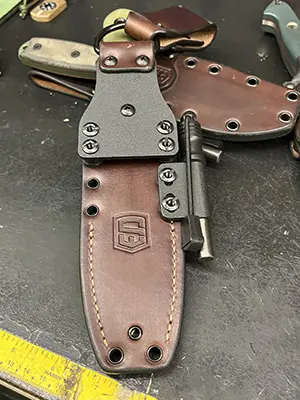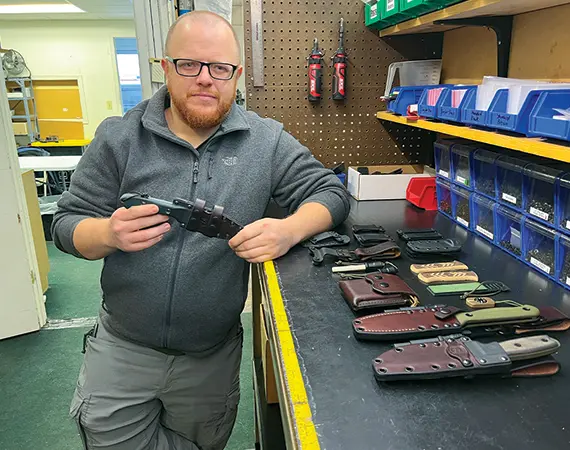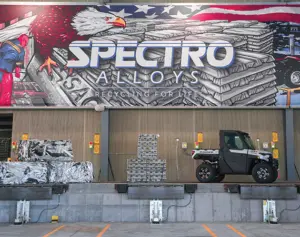Brian Gustad, founder of Sagewood Gear, a Duluth-based maker of knife sheaths and accessories, has been working to apply lean manufacturing principles to his two-person shop for years. But he says, “There’s only so much you can learn from reading books before you need someone to actually come in and show you how you can improve.”
Gesturing toward a bookshelf full of lean manufacturing literature, he says: “There’s a lot of good info, but the problem I had was how do I take enterprise-level manufacturing knowledge and apply it to a micro-manufacturing operation?”

Gustad found help at Duluth’s Entrepreneur Fund, which connected him with Ally Johnston, a business growth consultant for Enterprise Minnesota.
“What’s cool about Brian is he’s done a lot of lean initiatives on his own,” Johnston says.
Gustad says Johnston initially asked him to do some business analytics and then helped him scrutinize his shop layout.
“Basically, we wanted to completely revamp the entire shop and set it up for better flow — a good layout to optimize some of the equipment he has, including some new CNCs,” Johnston recalls.
The results speak for themselves. Gustad says a movement study showed efficiency improvements for key processes throughout the shop.
20 to 30% would be more accurate
Johnston also helped Gustad fine-tune a system he had already adopted to manage inventory. Inspired by Toyota, he uses kanban cards to track the necessary materials and components needed to produce his goods and ensure they always remain in steady supply.

Gustad’s eagerness to try out new ideas has impressed Johnston, who says proposed changes in small settings can often encounter resistance.
“I’ve seen a lot of craft manufacturers who don’t think lean will work for them, because they’re different than other manufacturers — they don’t mass produce at the same level. But that’s not his take. His take is that: ‘I want to figure out how to eliminate as much waste as possible.’” Johnston notes that the small size of the operation only heightens the need for efficiency.
Johnston also credits Gustad for changes he made before her arrival, including what she calls “a strategic pivot.”
At the height of the pandemic, as people spent more time online with stimulus money in their pockets, orders poured into Sagewood Gear, resulting in a backlog of about 16 weeks for many products.
Gustad struggled to catch up in part because of his diverse product line and the high level of skill required to get orders out the door.
Previously, Sagewood Gear offered three sheath designs for 40 different knife models in three different colors.
Sagewood has since narrowed its sheath selection to one-tenth of that, available in two colors: brown and black.
Gustad also sought to streamline production without sacrificing quality.
With only one part-time employee on the payroll at a time and the prospect of frequent churn, the higher-level leatherwork had typically fallen to Gustad, who realized, “There was no way I could expand, because I was the bottleneck in the whole process.”
Gustad responded both with new designs and with self-built tooling to support new production methods that have cut lead times to no more than four weeks for most products.
“It’s amazing what he can figure out on his own and make work,” Johnston says.
Gustad started leatherworking as a side gig in 2010, while he was still working as an auto mechanic.
Initially, Gustad did a lot of one-off work making unique sheaths for individual knives but says he soon found that was not a very profitable enterprise.
“So, I started moving more into the production-side of things and offering mostly after-market stuff for knives and sheaths,” he says.
Almost all Sagewood Gear’s orders are generated by its online marketing, and it sells products around the globe.
Gustad says Johnston has shaped his approach to business.
“She has taught me how to think when it comes to value streams. For instance, we went through a value stream mapping exercise, and she kind of showed me how to think about problem solving, without doing it for me,” he says.
This has helped Gustad decide where to focus his efforts.
“I’ve been doing more collaborative work with knife makers. But I’ve also been doing more bolt-on accessories for factory sheaths that people get with their knife. Some of them don’t want to spend 100-some bucks for a custom leather sheath. So, they just stick with the original one. But I offer carry attachments and other accessories, so it can actually be useful, because most factory knife sheaths, or at least the attachments for carrying them on your belt, are kind of garbage,” Gustad says.
Before Enterprise Minnesota entered the picture, Gustad says he felt left to his own devices, adding that he suspects that’s a common feeling for small-scale manufacturers like himself.
“There’s this big gap in knowledge for the small guy on how to become a larger manufacturer,” he says.
The Entrepreneur Fund was able to introduce Enterprise Minnesota to Gustad and fund its early support services. That work has continued with additional assistance from Duluth’s CareerForce Center.
Elena Foshay, Duluth’s director of workforce development, explains CareerForce is able to use a portion of its federal and state dislocated worker funding to support training for existing workers.
“The intention is to help avoid layoffs; it helps a company grow and create more jobs; and maybe it helps individuals earn higher wages,” Foshay says.
She notes that the program can provide up to $10,000 of annual support.
Jim Schottmuller, Enterprise Minnesota’s director of business development, says Sagewood was far enough along in its development that his organization could provide assistance.“It’s tough to suggest process improvements when a company hasn’t developed those processes yet,” Schottmuller says.
Gustad predicts such investments will pay off. “I feel like we need to help smaller businesses like mine, because they start as small fish but can turn into big fish if they just have the appropriate skills and knowledge and help.”
Gustad describes his progress over the past few years as incremental but steady.
“Lean manufacturing is like taking vitamins,” he says. “You’ve got to stick with it in order to see the benefits.”
Return to the Spring 2024 issue of Enterprise Minnesota® magazine.


